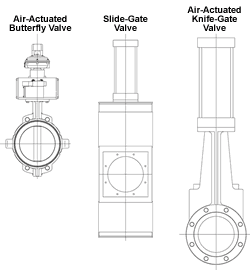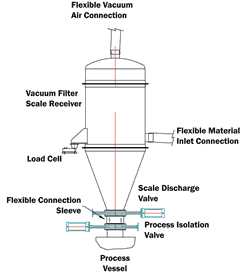Therapy for 'Over-Weight' Weigh-Hopper Scales
Scale performance inaccuracies are typically false-positive weights where the scale reads more material than it is actually receiving. There are steps to manage mechanical scale issues.
Most batch-type feeding systems for fiber-reinforced composites or PVC compounding involve a gain-in-weight scale or weighing vessel of some form or another. Problems with scale performance (or lack thereof) are typically false-positive weights. The scale “reads” more material than it is actually receiving because something is putting extra weight on the vessel. That means your process gets less material than it should. This may lead to variations in formula accuracy, which ultimately show up as a manufacturing problem or product-quality deficiency.
Typically, scales are gain-in-weight type and are fed raw materials either mechanically (such as with a screw conveyor) or pneumatically with a pressure-conveying system or vacuum receiver. (There is another possibility: using loss-in-weight scales, which are typically dedicated to one material, filled volumetrically, and discharged by weight.)
Regardless of the feeding process, gain-in-weight scales have a preset weight, or setpoint. The scale is fed a given volume of material until that weight is achieved. Then the feed stream for that material is disabled. Scales that are fed with multiple materials should have multiple setpoints. Or for more accurate feeding, the system may use an individual weigh hopper for each ingredient.
Most scale performance issues are either mechanical or electronic (controls-related). Controls issues are rare, since most components are solid-state and don't cause problems unless someone tampers with the controller or there is a wiring failure. So for practical purposes, we'll just focus on the potential mechanical scaling issues. Remember that we’re talking about a batch-type vacuum-conveying operation in which the scale hopper fills up with material and then discharges it. That cycle repeats over and over again.
Look for the obvious first
The easiest thing to look for right from the start is whether there is anything on the scale that shouldn't be there—an errant tool, a broom leaning against it, a test weight left in place. Nothing should be placed on or against the scale that adds weight. The load cells read the amount of pressure put on them and convert that pressure to a volumetric value. Load cells treat the weight of a hammer, mallet, or partial can of paint the same as the material being fed into the weigh hopper.
Once you're sure there's nothing on the scale, check any physical connections to it, such as electrical conduit, compressed-air connections, flow socks, or flexible sleeves. None of these connections should impart adverse influence on the scale. Make sure that anything connected to the scale is flexible enough not to impede the scale’s weight-sensing ability. Don’t make the mistake of assuming that just because something looks flexible, it is. Flexible hose and electrical conduit can become rigid as they age.
If nothing is obviously wrong, ask yourself, “What has changed?” Has any new piece of equipment or other device recently been replaced or added? Say, for example, that you removed a butterfly valve from the scale and replaced it with a knife gate. If these are not the same weight, you need to re-tare the vessel.
If nothing has changed, then something is broken or failing. Take a step back and observe a few cycles. Consider everything that occurs in the weighing process. Look and listen to every component, valve, or vent associated with the scale.
Usually failure occurs during the fill cycle, but you should also look at what happens beneath the scale while it discharges. Sometimes the process device into which your scale discharges may build up internal pressures during filling. These internal pressures must be vented away or isolated from the scale. Your original installation should have accounted for this. If not, then your blending/scaling process design should be examined and revised to mitigate these conditions.
Visually inspect all valve seats and check for leaks. This is especially important if your scale is on a vacuum receiver. Remember, it's a negative-pressure system, so there may be no telltale material leaking out, but only air being sucked in.
Hidden leaks
In one real-life troubleshooting instance that involved feeding a dry powder, weigh-scale performance was getting progressively worse and worse. A thorough visual examination found all process and utility connections were properly flexible, and everything was correct. Maintenance reports showed that nothing had recently been changed on the vessel. Everything was as originally installed.
We then stepped back and watched a few cycles carefully. That's when we noticed that the flexible fabric sleeve between the scale’s discharge valve and the process isolation valve below was sucking in during the vacuum filling sequence. This should not occur, since the scale’s discharge valve is supposed to be completely closed during the fill cycle. Yet a vacuum was being created beneath the valve.
We visually determined that the valve was indeed moving its full range of travel. Nothing prevented it from closing completely. We then decided to disable the batching system and remove the flexible sleeve between the scale’s discharge valve and the process-blending isolation valve below it.
While shining a flashlight up from below the discharge valve in its closed position, we opened an inspection port on the scaling vessel and looked down to the valve below. We could see the light coming through what turned out to be pinholes in the blade of the valve. The valve blade is the part that physically shuttles to open or close the valve.
Over time, the valve seat had started to wear. Even though the valve was in the closed position, a small amount of air was leaking past the valve's sealing joint leading to and above the valve's blade during the fill sequence. This small amount of leaking air had enough velocity to cause the material collected inside the vessel to swirl. Because of the abrasive nature of the powder material, it began eating away at the thick stainless-steel valve blade and eventually wore holes through it, creating an unseen vacuum leak.
Because the process isolation valve was closed beneath the scale's discharge valve and the void space between the valves was enclosed by a flexible sleeve, the system's negative vacuum pressure was now pulling the scale down towards the process isolation valve, causing the scale to read several pounds heavier than it actually was. So the system was receiving that much less material than the formulation called for with every batch.
Michael Descoteaux has worked 28 years in engineering and troubleshooting materials-handling systems for plastics, especially wood/plastic composites, first with Pacific Engineering and since 2000 with O.A. Newton & Sons, Bridgeville, Del. He welcomes questions from readers at mike.descoteaux@oanewton.com
Related Content
Bulk-Bag Filler Equipped with Pallet Dispenser
Between 14-16 pallets can be loaded for staging into the pallet dispenser.
Read MoreNovatec Putting the ‘Smart’ In Resin Drying, Conveying
NPE2024: Machine builder gets ‘ludicrous’ by rewriting the rules for material drying and conveying.
Read MoreHigh-Capacity Bulk Bag Discharger Can Be Moved Around
Equipped with a flexible screw conveyor, unit enables rapid, dust-free discharging and conveying of bulk solid materials at multiple plant locations.
Read MoreDeflection Elbows Eliminate Streamers for Large Film Processor
New elbows eliminate troublesome streamers to increase productivity at leading blown film processor.
Read MoreRead Next
See Recyclers Close the Loop on Trade Show Production Scrap at NPE2024
A collaboration between show organizer PLASTICS, recycler CPR and size reduction experts WEIMA and Conair recovered and recycled all production scrap at NPE2024.
Read MoreMaking the Circular Economy a Reality
Driven by brand owner demands and new worldwide legislation, the entire supply chain is working toward the shift to circularity, with some evidence the circular economy has already begun.
Read MorePeople 4.0 – How to Get Buy-In from Your Staff for Industry 4.0 Systems
Implementing a production monitoring system as the foundation of a ‘smart factory’ is about integrating people with new technology as much as it is about integrating machines and computers. Here are tips from a company that has gone through the process.
Read More






















